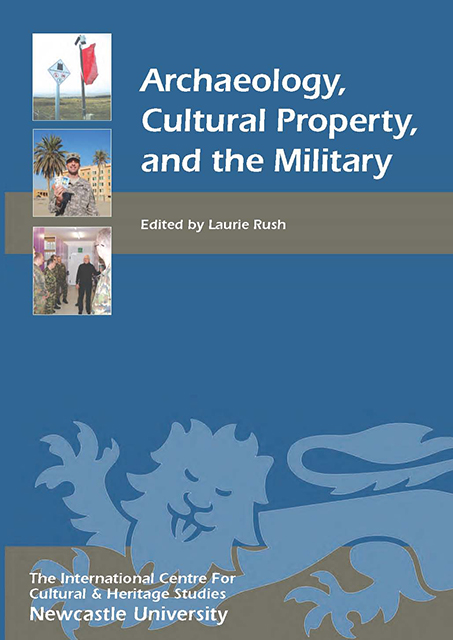Book contents
- Frontmatter
- Contents
- List of Illustrations: Figures and Tables
- Archaeology and the Military: An Introduction
- 1 The Obligations Contained in International Treaties of Armed Forces to Protect Cultural Heritage in Times of Armed Conflict
- 2 Rescuing Europe’s Cultural Heritage: The Role of the Allied Monuments Officers in World War II
- 3 The UK’s Training and Awareness Programme
- 4 US Army Civil Affairs: Protecting Cultural Property, Past and Future
- 5 Cultural Property Protection in the Event of Armed Conflict: Deploying Military Experts or Can White Men Sing the Blues?
- 6 Good Training and Good Practice: Protection of the Cultural Heritage on the UK Defence Training Estate
- 7 In-Theatre Soldier Training through Cultural Heritage Playing Cards: A US Department of Defense Example
- 8 Dealing the Heritage Hand: Establishing a United States Department of Defense Cultural Property Protection Program for Global Operations
- 9 Teaching Cultural Property Protection in the Middle East: The Central Command Historical/Cultural Advisory Group and International Efforts
- 10 Cultural Resources Data for Heritage Protection in Contingency Operations
- 11 Time not on my Side: Cultural Resource Management in Kirkuk, Iraq
- 12 US Military Support of Cultural Heritage Awareness and Preservation in Post-Conflict Iraq
- 13 Operation Heritage
- 14 Cultural Property Protection in the Event of Armed Conflict – Austrian Experiences
- 15 The Role of the Swiss Armed Forces in the Protection of Cultural Property
- 16 Preserving Global Heritage from Space in Times of War
- Appendix 1 1954 Hague Convention and its two Protocols
- Appendix 2 Author Biographies
- Index
4 - US Army Civil Affairs: Protecting Cultural Property, Past and Future
Published online by Cambridge University Press: 28 February 2023
- Frontmatter
- Contents
- List of Illustrations: Figures and Tables
- Archaeology and the Military: An Introduction
- 1 The Obligations Contained in International Treaties of Armed Forces to Protect Cultural Heritage in Times of Armed Conflict
- 2 Rescuing Europe’s Cultural Heritage: The Role of the Allied Monuments Officers in World War II
- 3 The UK’s Training and Awareness Programme
- 4 US Army Civil Affairs: Protecting Cultural Property, Past and Future
- 5 Cultural Property Protection in the Event of Armed Conflict: Deploying Military Experts or Can White Men Sing the Blues?
- 6 Good Training and Good Practice: Protection of the Cultural Heritage on the UK Defence Training Estate
- 7 In-Theatre Soldier Training through Cultural Heritage Playing Cards: A US Department of Defense Example
- 8 Dealing the Heritage Hand: Establishing a United States Department of Defense Cultural Property Protection Program for Global Operations
- 9 Teaching Cultural Property Protection in the Middle East: The Central Command Historical/Cultural Advisory Group and International Efforts
- 10 Cultural Resources Data for Heritage Protection in Contingency Operations
- 11 Time not on my Side: Cultural Resource Management in Kirkuk, Iraq
- 12 US Military Support of Cultural Heritage Awareness and Preservation in Post-Conflict Iraq
- 13 Operation Heritage
- 14 Cultural Property Protection in the Event of Armed Conflict – Austrian Experiences
- 15 The Role of the Swiss Armed Forces in the Protection of Cultural Property
- 16 Preserving Global Heritage from Space in Times of War
- Appendix 1 1954 Hague Convention and its two Protocols
- Appendix 2 Author Biographies
- Index
Summary
Tragic events such as the burning of the National Library of Bosnia in Sarajevo, the obliteration of the great Buddhas at Bamiyan and, in particular, the looting of the Iraq National Museum in 2003 have led to discussions about how military organisations around the world deal with avoiding damage to cultural property while waging an armed conflict. Much of the debate centres on whether or not cultural heritage professionals should provide information and advice regarding the protection of important cultural sites in the theatre of operations to military planners or whether providing such advice is unethical, actually making it easier to wage war.
However, this debate does not seem to acknowledge the historic role of cultural heritage professionals during wartime. In fact, during World War II, American and European cultural property professionals were inextricably involved in government and military efforts to protect cultural heritage. Through their efforts, the US Army Civil Affairs Division and several Allied nations developed a small number of teams of cultural heritage professionals within the military ranks called the Monuments, Fine Arts and Archives (MFA…A) teams. Nicknamed the ‘Monuments Men’, they were relatively successful in protecting, salvaging and repatriating many thousands of important cultural objects during the course of the war and beyond (see, for example, Nicholas 1995 and Spirydowicz, this volume). Many of these Monuments Men and Women went on to become important contributors to the cultural heritage profession in the post-war era: Italian Renaissance expert Frederick Hartt; Richard Davis, later director of the Minneapolis Institute of Arts; James Rorimer, later director of the Metropolitan Museum of Art; and Edith Standon, later curator of textiles at the Metropolitan Museum of Art, to name just a few. In all, there were fewer than 100 members of these special teams (Edsel 2006), but through their efforts many objects and icons of our shared cultural heritage were saved. Paintings by Da Vinci, Vermeer and Van Eyck were saved from destruction and many thousands of stolen works of art were repatriated. Towards the end of the war, as the Allies began the final push towards Berlin, they began to discover Nazi looted art in caches throughout Austria and Germany.
- Type
- Chapter
- Information
- Archaeology, Cultural Property, and the Military , pp. 34 - 40Publisher: Boydell & BrewerPrint publication year: 2010
- 4
- Cited by



